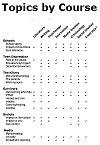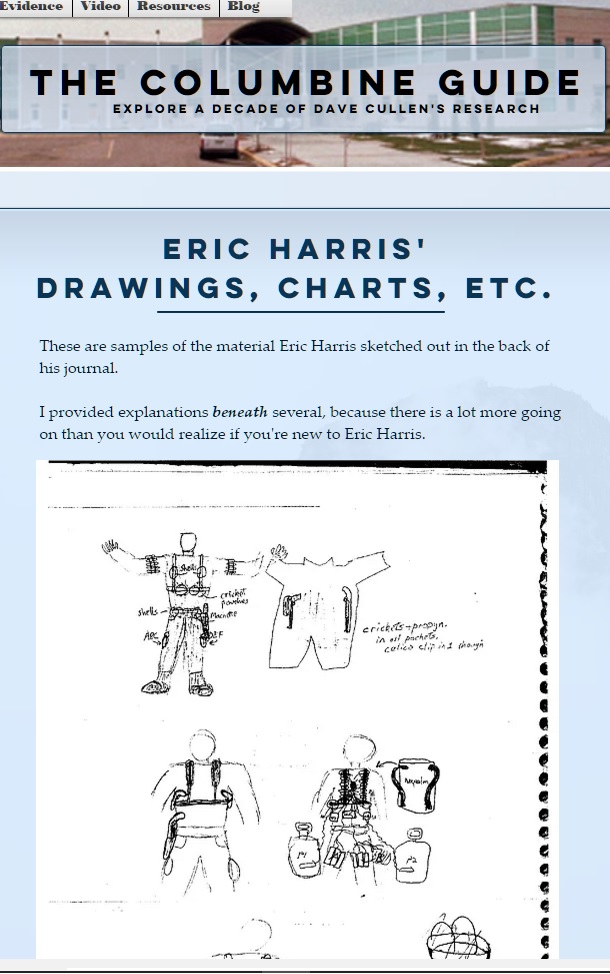Psychopathy Case Study: Eric Harris
Core Topics
- Popular understanding and misconceptions
- Characteristics
- Identify all 20
- Tell-tale signs
- Scoring Eric
- How much does psychopathy explain Eric? Limitations?
- Causes
- Treatment
- The treatment conundrum
- Did treatment make Eric worse?
- Future hope for treatment
- Juveniles: early warning signs
- Eric Harris: the rare sadistic/killer psychopath
- Eric’s progression:
- Petty thief to felony theft to murder
- Human extinction fantasies to blowing up a high school
- Fantasy to reality
- Identifying the charming psychopath
Advanced Topics:
- Recent advances with fMRIs
- Ten subtypes (See reading by Theodore Millon)
- Onset age—controversy over diagnosing juveniles
- In-depth on The Psychopathy Checklist
- Characteristics
- Scoring
- Historical developments
- Terminology debates: sociopath and APD
- Exclusion from DSM
Reading Assignments:
Columbine passages, pages:
- 134-136
- 168-170
- 239-246 (Chapter 40, “Psychopath”)
- 378-379 (in the Notes)
Discussion Questions
-
Identify the key characteristics of a psychopath. Explain how psychopathy differs from psychosis, and why it’s so dangerous. Illustrate how Eric Harris fit the profile. Were there any contradictions between his behavior and the profile?
-
Where do psychopaths come from? Describe the current theories. Pick one and defend it?
-
How often are psychopaths violent? Explain which subset of psychopathy Eric Harris falls into.
-
Can psychopathy be cured? What have we learned about treatment?
-
Identify the early warning signs of psychopathy.
-
How does Eric match up with the psychopathy checklist in the book’s endnotes for chapter 40? Take your own shot at rating him on each item. What score do you get for him?
-
Therapy often provides psychopaths with the means of better manipulating people. Do you believe this was true for Eric? If so, in what ways? What is your opinion of the treatment programs such as the one proposed by Dr. Hare or put in place by Dr. Caldwell at the juvenile treatment center in Wisconsin? Do you think they show promise?
-
The author notes a resistance to diagnosing minors as psychopaths. Why do you think there is this resistance? Do you think there would have been a different outcome if Eric had been diagnosed a psychopath?
-
The book cites two literary characters as perfect psychopaths: Iago from Othello, and the narrator of Notes from Underground. (Both invented before the diagnosis even existed.) Read one of the works—or the first twenty pages—and rate each character on Dr. Hare’s Psychopathy Checklist. (The checklist and instructions are in the book’s endnotes for chapter 40 on page 398.) What score do you calculate for each? Where does that put them on the psychopathy spectrum?
-
Explain the terminology confusion between the terms psychopath, sociopath and anti-social personality disorder (APD). How is APD different? Why do Dr. Hare and many of his peers find it unuseful? Why is psychopathy (or sociopathy) not in the DSM-IV.
Further Reading
Primary Outside Readings on Psychopathy
-
Caldwl, Michael F., David J. McCormick, Deborah Umstead and Gregory J. Van Rybroek. "Evidence of Treatment Progress and Therapeutic Outcomes Among Adolescents with Psychopathic Features." Criminal Justice and Behavior 34 (2007): 573-587. http://cjb.sagepub.com/cgi/content/abstract/34/5/573
-
Cleckley, Hervey. The Mask of Sanity: An Attempt to Clarify Some Issues About the So-Called Psychopathic Personality. 5th ed., 1988.
-
Hare, Robert D. Hare Psychopathy Checklist-Revised (PCL-R), 2nd ed. Toronto: Multi-Health Systems, 2003.
-
———. Without Conscience. Guilford Press, 1999.
-
———. Robert Hare's Web Page Devoted to the Study of Psychopathy.
-
Kiehl, Kent A., Alan T. Bates, Kristin R. Laurens. Robert D. Hare, and Peter F. Liddle. "Brain Potentials Implicate Temporal Lobe Abnormalities in Criminal Psychopaths." Journal of Abnormal Psychology 115, no. 3 (2006): 443– 453.
-
Millon , Theodore, and Roger D. Davis. Psychopathy: Antisocial, Criminal, and Violent Behavior. New York: Guilford Press, 1998.
-
Millon , Theodore, Erik Simonsen, Roger D. Davis and Morten Birket-Smith. "Ten Subtypes of Psychopathy." In Millon and Davis, Psychopathy: Antisocial, Criminal, and Violent Behavior, pp. 161-70.
Supplemental Outside Readings on Psychopathy
-
Seabrook, John. "Suffering Souls: The search for the roots of psychopathy." The New Yorker. November 10, 2008.
-
Glenn, Andrea L., Adrian Raine, Peter H. Venables, and Sarnoff A. Mednick. "Early Temperamental and Psychophysiological Precursors of Adult Psychopathic Personality." Journal of Abnormal Psychology 116, no. 3 (2007): 508-518.
-
Wong, Stephen C. P., PhD and Robert D. Hare, PhD. Guidelines for a Psychopathy Treatment Program. Toronto: Multi-Health Systems, 2006.




